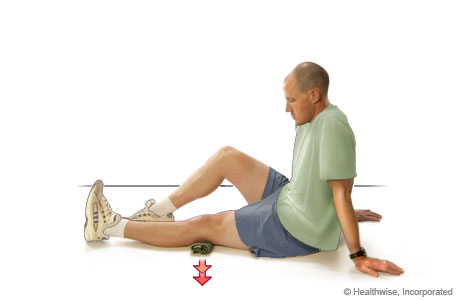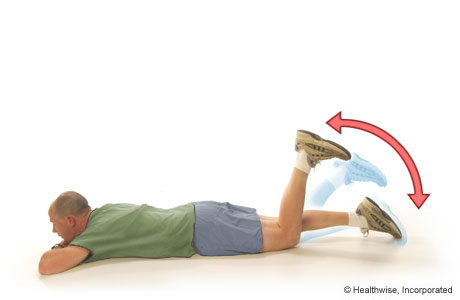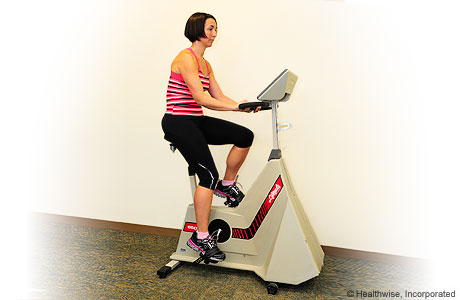Knee exercises for osteoarthritis
These exercises can help stretch and strengthen your leg muscles and reduce knee pain and stiffness. Before you try any of these exercises, talk to your doctor or physical therapist. He or she can help design an exercise plan that is best for you.
If you feel pain when you do these exercises, stop. Ask your doctor or physical therapist if there are other exercises that you can do to keep your muscles flexible and strong.
Knee flexion with heel slide

- Lie on your back with your knees bent.
- Slide your heel back by bending your affected knee as far as you can. Then hook your other foot around your ankle to help pull your heel even farther back.
- Hold for about 6 seconds, then rest for up to 10 seconds.
- Repeat 8 to 12 times.
- Switch legs and repeat steps 1 through 4, even if only one knee is sore.
Quad sets

- Sit with your affected leg straight and supported on the floor or a firm bed. Place a small, rolled-up towel under your knee. Your other leg should be bent, with that foot flat on the floor.
- Tighten the thigh muscles of your affected leg by pressing the back of your knee down into the towel.
- Hold for about 6 seconds, then rest for up to 10 seconds.
- Repeat 8 to 12 times.
- Switch legs and repeat steps 1 through 4, even if only one knee is sore.
Straight-leg raises to the front

- Lie on your back with your good knee bent so that your foot rests flat on the floor. Your affected leg should be straight. Make sure that your low back has a normal curve. You should be able to slip your hand in between the floor and the small of your back, with your palm touching the floor and your back touching the back of your hand.
- Tighten the thigh muscles in your affected leg by pressing the back of your knee flat down to the floor. Hold your knee straight.
- Keeping the thigh muscles tight and your leg straight, lift your affected leg up so that your heel is about 12 in. (30 cm) off the floor. Hold for about 6 seconds, then lower slowly.
- Relax for up to 10 seconds between repetitions.
- Repeat 8 to 12 times.
- Switch legs and repeat steps 1 through 5, even if only one knee is sore.
Active knee flexion

- Lie on your stomach with your knees straight. If your kneecap is uncomfortable, roll up a washcloth and put it under your leg just above your kneecap.
- Lift the foot of your affected leg by bending the knee so that you bring the foot up toward your buttock. If this motion hurts, try it without bending your knee quite as far. This may help you avoid any painful motion.
- Slowly move your leg up and down.
- Repeat 8 to 12 times.
- Switch legs and repeat steps 1 through 4, even if only one knee is sore.
Quadricep stretch (facedown)

- Lie flat on your stomach, and rest your face on the floor.
- Wrap a towel or belt strap around the lower part of your affected leg. Then use the towel or belt strap to slowly pull your heel toward your buttock until you feel a stretch.
- Hold for about 15 to 30 seconds, then relax your leg against the towel or belt strap.
- Repeat 2 to 4 times.
- Switch legs and repeat steps 1 through 4, even if only one knee is sore.
Stationary exercise bike

If you do not have a stationary exercise bike at home, you can find one to ride at your local health club or community center.
- Adjust the height of the bike seat so that your knee is slightly bent when your leg is extended downward. If your knee hurts when the pedal reaches the top, you can raise the seat so that your knee does not bend as much.
- Start slowly. At first, try to do 5 to 10 minutes of cycling with little to no resistance. Then increase your time and the resistance bit by bit until you can do 20 to 30 minutes without pain.
- If you start to have pain, rest your knee until your pain gets back to the level that is normal for you. Or cycle for less time or with less effort.
Current as of: June 26, 2019
Author: Healthwise Staff
Medical Review:Anne C. Poinier MD – Internal Medicine & Adam Husney MD – Family Medicine & Kathleen Romito MD – Family Medicine & Joan Rigg PT, OCS – Physical Therapy
This information does not replace the advice of a doctor. Healthwise, Incorporated, disclaims any warranty or liability for your use of this information. Your use of this information means that you agree to the Terms of Use. Learn how we develop our content.

